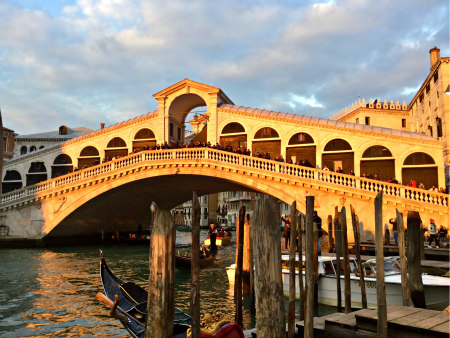 |
| Detail from Saint Ursula Cycle by Carpaccio - Photo: Cat Bauer |
Carpaccio (circa 1460-1525) was a young painter who came of age with the Saint Ursula Cycle. He created nine paintings for the Scuola di Sant'Orsola, a devotional confraternity once located near the Basilica of Santi Giovanni e Paolo down in the Castello zone of Venice.
The Scuola of Sant'Orsola was founded on July 15, 1300. On November 26, 1488, it decided to decorate its headquarters. Enter Carpaccio, who was then about 25-30 years-old.
 |
| Saint Ursula Cycle - detail2 - Photo: Cat Bauer |
What was happening in Venice around that time:
In 1453, the Ottoman Turk Mehmed II had conquered Constantinople, turning it into Istanbul, destroying the over-1000-year-old Byzantine Empire and utterly transforming the order of the world. Some of the most horrific stories were about young mothers, virgins and nuns who were torn from their homes and debased.
The Ottomans were the archenemies of the aristocratic Venetian Loredan family, which was packed full of doges, admirals and captains, and known for their military feats, especially against the Ottomans. The Loredans were patrons of the Scuola of Sant'Orsola and probably commissioned the Saint Ursula paintings.
 |
| Saint Ursula Cycle detail - before restoration - Photo: Cat Bauer |
Who was Saint Ursula?
There is no historic evidence that Saint Ursula ever existed, but people love her anyway. Her legend has many different variations, depending on the source. Carpaccio, too, created his own story line, mixing Venetian traditions with fantasy backdrops. The cycle is sort of like a Hollywood remake of an ancient story about a 4th century princess from Britain, but transported 1,000 years into the future to the time of the Venetian Renaissance.
According to legend, Saint Ursula was the daughter of a Christian king from Brittany who died in... let's say 383 AD. The princess Ursula was supposed to marry the son of a pagan king with the condition that he make a pilgrimage with her (and her 11,000 virgin ladies-in-waiting) to meet the pope and convert to Christianity. The prince agreed, and off they went to Rome. On her way back home, she and her entourage (which included the pope -- I am not clear why he was on the trip -- some say because he was smitten with Ursula and her virgins) passed through Cologne where they ran into Attila the Hun, who wanted to marry Ursula, who refused, so he chopped off everyone's heads -- except for Ursula, who was shot with an arrow.
What backs up that story is the Church of Saint Ursula in Cologne, built in the 12th century on top of a Roman graveyard, which is eerily decorated with thousands of bones.
 |
| Venice Carnival 2018 - La Festa Veneziana dell'Acqua - Photo: Cat Bauer |
Included in the paintings are members of the Campagnie delle Calze, which were theatrical associations made up of noblemen that ran around Venice putting on events like masked watery processions on the canals (which Venice still does to this very day -- the opening of Carnival yesterday was entitled: La Festa Veneziana dell'Acqua which took place on the Cannaregio Canal). Calza means "sock" in Italian, and the companies were known for their distinctive hosiery. I was riveted by the intricate embroidery of one young man's sock.
 |
| Detail - Socks - Saint Ursula Cycle by Carpaccio - Photo: Cat Bauer |
 |
| Behind the scenes - Carpaccio restoration - Photo: Cat Bauer |
The restoration of the Saint Ursula Cycle is expected to be completed in 2019 when the nine paintings will be back at home in the gallery room inside the Accademia designed by the renowned Venetian architect, Carlo Scarpa.
Ciao from Venezia,
Cat Bauer
Venetian Cat - The Venice Blog
















